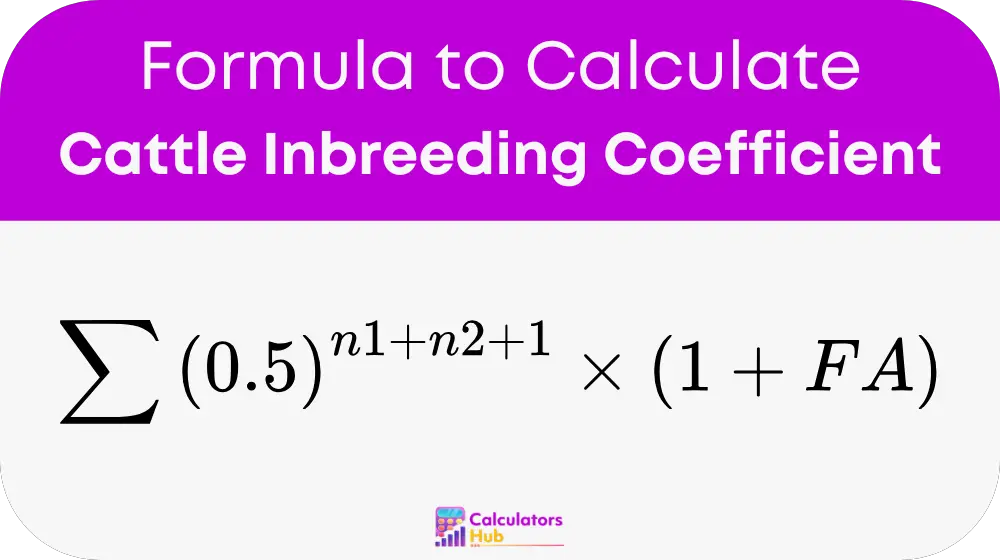The Cattle Inbreeding Coefficient Calculator is an essential tool for breeders and livestock managers who want to assess and control the genetic health of their herds. Inbreeding in cattle refers to the mating of closely related individuals, which can lead to a higher likelihood of genetic defects and reduced vitality in offspring. This calculator helps to determine the inbreeding coefficient, a measure of genetic relatedness between two individuals.
The inbreeding coefficient indicates the probability that an individual will inherit two identical alleles for a given gene, one from each parent. By calculating this coefficient, breeders can make informed decisions to avoid excessive inbreeding, which could negatively affect the cattle’s overall health and productivity.
Formula of Cattle Inbreeding Coefficient Calculator
The formula to calculate the inbreeding coefficient (F) is:

Where:
- F = Inbreeding coefficient of the individual.
- Σ = Summation over all common ancestors of the individual’s parents.
- n1 = Number of generations from the common ancestor to one parent.
- n2 = Number of generations from the common ancestor to the other parent.
- FA = Inbreeding coefficient of the common ancestor.
This formula takes into account the relationship between the two parents and any common ancestors in the pedigree, providing an accurate measure of inbreeding in the individual.
General Terms for Cattle Inbreeding Coefficient Calculations
Below is a table with terms commonly used in cattle inbreeding coefficient calculations. This can be useful to understand the process without requiring constant recalculations.
| Term | Definition |
|---|---|
| Inbreeding Coefficient (F) | A numerical value representing the degree of inbreeding in an individual. |
| n1 and n2 | The number of generations from the common ancestor to each parent. |
| Common Ancestor | An ancestor shared by both parents in the pedigree. |
| FA | Inbreeding coefficient of the common ancestor. |
| Generations | The number of generations separating an individual from a common ancestor. |
This table provides quick access to key concepts, ensuring you can make accurate calculations and better understand the inbreeding process in cattle breeding.
Example of Cattle Inbreeding Coefficient Calculator
To illustrate how to use the inbreeding coefficient formula, let’s consider an example:
Suppose two cattle, Cow A and Cow B, are related through a common ancestor that is three generations removed from Cow A and two generations removed from Cow B. The common ancestor has an inbreeding coefficient (FA) of 0.125.
Using the formula, we can calculate the inbreeding coefficient as follows:
Inbreeding Coefficient (F) = Σ[(0.5)^(n1 + n2 + 1) * (1 + FA)]
For this example:
- n1 = 3 (number of generations from the common ancestor to Cow A)
- n2 = 2 (number of generations from the common ancestor to Cow B)
- FA = 0.125 (inbreeding coefficient of the common ancestor)
The inbreeding coefficient calculation will be:
F = (0.5)^(3 + 2 + 1) * (1 + 0.125)
F = 0.015625 * 1.125 = 0.017578125
The inbreeding coefficient for this pairing is approximately 0.0176, which indicates a low degree of inbreeding between these two cattle.
Most Common FAQs
The inbreeding coefficient is essential because it helps breeders assess the genetic diversity of their herd. High inbreeding levels can result in the expression of harmful recessive traits, which can affect the health, growth, and reproductive success of cattle. Keeping the inbreeding coefficient low ensures a healthier and more genetically diverse herd.
To reduce inbreeding, you can track the genetic relationship between cattle using detailed pedigrees and avoid pairing animals that share common ancestors in close generations. Additionally, introducing new genetic material from outside the herd can help maintain genetic diversity and reduce the risk of inbreeding.
The ideal inbreeding coefficient varies depending on the breed and specific breeding goals. However, a low inbreeding coefficient is generally preferred, as it indicates less genetic relatedness between the parents, which helps prevent the expression of genetic disorders. A coefficient of 0.05 or lower is often seen as a safe threshold to avoid inbreeding depression.